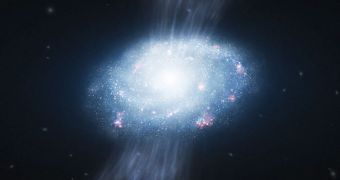A team of astronomers has been able to demonstrate for the first time that young galaxies can accumulate nearby cosmic gas in order to fuel their growth over time.
This is done by using cool hydrogen gas to produce new, blue stars in specialized regions called stellar nurseries. There areas can be found throughout galaxies.
The observations that provided direct evidence of this phenomenon were conducted using the Very Large Telescope (VLT), which is operated by the European Southern Observatory (ESO), in Chile.
The team behind the investigation says that one of the main problems in modern astrophysics is explaining how young galaxies grow so dramatically in their first few billion years.
These observations may be used to explain this mystery, experts explain in the October 14 issue of the esteemed scientific journal Nature.
Astrophysicists say that the earliest galaxies appeared less than one billion years after the Big Bang, and say that these structures were a lot smaller than behemoths such as the Milky Way.
Galaxies such as our own grew to their current size by merging with dwarf galaxies around them, or after collisions with equally-large galaxies in their immediate vicinity.
But one of the puzzles confronting experts was explaining how is it that average galaxy sizes appear to increase as the Universe is getting older.
What some scientists neglected to take into account was the fact that some of the earliest galaxies developed in a Universe that was filled with large clouds of hydrogen and helium gas.
The team that conducted the research, based at the Osservatorio Astrofisico di Arcetri, explains that accretion was most likely a common phenomenon around the first billion years after the Big Bang.
“The new results from the VLT are the first direct evidence that the accretion of pristine gas really happened and was enough to fuel vigorous star formation and the growth of massive galaxies in the young Universe,” says team leader Giovanni Cresci.
One of the most important implications for the new research is that textbooks that explain how galaxies evolved over time may need to be rewritten.
“This study has only been possible because of the outstanding performance of the SINFONI [spectrograph] instrument on the VLT. It has opened a new window for studying the chemical properties of very distant galaxies,” the expert says.
“SINFONI provides information not only in two spatial dimensions, but also in a third, spectral dimension, which allows us to see the internal motions inside galaxies and study the chemical composition of the interstellar gas,” he concludes.

 14 DAY TRIAL //
14 DAY TRIAL //